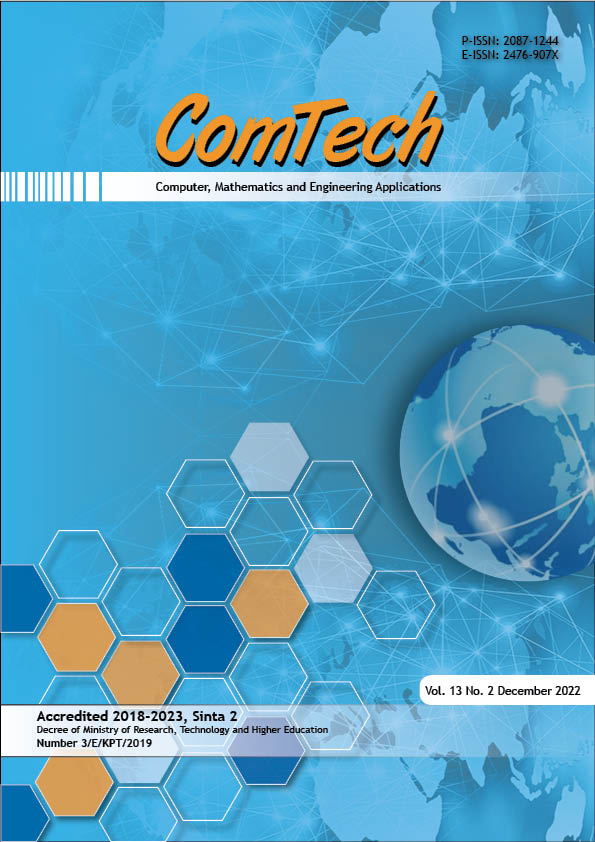Modeling Automatic Room Temperature and Humidity Monitoring System with Fan Control on the Internet of Things
DOI:
https://doi.org/10.21512/comtech.v13i2.7433Keywords:
automatic room temperature, humidity monitoring system, fan control, Internet of Things (IoT)Abstract
The Internet of Things (IoT) aims to expand the benefits of being connected to the Internet network continuously. It functions as a control system that has been widely applied in various fields because in certain case people are not allowed in certain rooms for security reasons. The research aimed to create a temperature and humidity monitoring system using as many fan controls as expected by utilizing IoT. The model used input in the form of temperature and humidity sensors. The output was a motor driver that drove a fan and used a microcontroller as the main processor. IoT-based systems consisted of hardware and software. Hardware included NodeMCU ESP8266 V3, DHT22 sensor, L298N motor driver module, fan, and computer. Meanwhile, the microcontroller software was made using Arduino IDE. From the test results, the system model works well. Fan control is set manually based on desired room temperature and humidity monitoring based on IoT. A mobile phone can also monitor temperature and humidity and control fans. The DHT22 sensor can read temperature and humidity every two seconds so that the resulting data is stable to display. Then, the L298N motor driver can adjust the fan speed with Pulse Width Modulation (PWM) using analog data ranging from 1 to 1.024.
References
Ab Rahman, R., Hashim, U. R. A., & Ahmad, S. (2020). IoT based temperature and humidity monitoring framework. Bulletin of Electrical Engineering and Informatics, 9(1), 229–237.
Adani, F., & Salsabil, S. (2019). Internet of things: Sejarah teknologi dan penerapannya. Jurnal Online Sekolah Tinggi Teknologi Mandala, 14(2), 92–99.
Adhiwibowo, W., Daru, A. F., & Hirzan, A. M. (2020). Temperature and humidity monitoring using DHT22 sensor and Cayenne API. Jurnal Transformatika, 17(2), 209–214.
Al Dahoud, A., & Fezari, M. (2018). NodeMCU V3 for fast IoT application development. Retrieved from https://galopago.github.io/assets/pdf/NodeMCUV3.pdf
Attubel, M., Siswanto, D., & Mukhsim, M. (2019). Sistem monitoring perawatan kendaraan berbasis Internet of Things (IOT). In Conference on Innovation and Application of Science and Technology (CIASTECH) (pp. 331–338).
Budiyanta, N. E., Tanudjaja, H., & Mulyadi, M. (2019). Rancang bangun robot line follower portable sebagai upaya minimalisasi sampah elektronik di ranah robotika. TESLA: Jurnal Teknik Elektro, 20(2), 148–156.
Jacksi, K., & Abass, S. M. (2019). Development history of the world wide web. International Journal of Scientific & Technology Research, 8(9), 75–79.
Mihai, B. (2016). How to use the DHT22 sensor for measuring temperature and humidity with the arduino board. Acta Uiversitatis Cibiniensis–Technical Series, 68, 22–25.
Paul, A., & Jeyaraj, R. (2019). Internet of things: A primer. Human Behavior and Emerging Technologies, 1(1), 37–47.
Puspasari, F., Satya, T. P., Oktiawati, U. Y., Fahrurrozi, I., & Prisyanti, H. (2020). Analisis akurasi sistem sensor DHT22 berbasis arduino terhadap thermohygrometer standar. JFA (Jurnal Fisika dan Aplikasinya), 16(1), 40–45.
Putra, R. F. H., Lhaksmana, K. M., & Adytia, D. (2018). Aplikasi IoT untuk rumah pintar dengan fitur prediksi cuaca. eProceedings of Engineering, 5(1), 1746–1760.
Putri, A. R., & Rahayu, P. N. (2020). Food warmer system based on DHT-22. JAREE (Journal on Advanced Research in Electrical Engineering), 4(1), 56–63.
Selvarasi, R., Aswini, & Pandian, A. A. (2019). Smart city based on street light and garbage monitoring by using IOT. JASC: Journal of Applied Science and Computations, VI(III), 55–64.
Shahid, N., & Aneja, S. (2017). Internet of things: Vision, application areas and research challenges. In 2017 International Conference on I-SMAC (IoT in Social, Mobile, Analytics and Cloud)(I-SMAC), (pp. 583–587). IEEE
Utomo, M. A. P., Aziz, A., & Harjito, B. (2019). Server room temperature & humidity monitoring based on Internet of Thing (IoT). Journal of Physics: Conference Series, 1306(1), 1–8.
Vinola, F., Rakhman, A., & Sarjana, S. (2020). Sistem monitoring dan controlling suhu ruangan berbasis Internet of things. Jurnal Teknik Elektro dan Komputer, 9(2), 117–126.
Downloads
Published
How to Cite
Issue
Section
License
Copyright (c) 2022 Fivtatianti Hendajani, Arif Mughni, Ire Puspa Wardhani, Abdul Hakim

This work is licensed under a Creative Commons Attribution-ShareAlike 4.0 International License.
Authors who publish with this journal agree to the following terms:
a. Authors retain copyright and grant the journal right of first publication with the work simultaneously licensed under a Creative Commons Attribution License - Share Alike that allows others to share the work with an acknowledgment of the work's authorship and initial publication in this journal.
b. Authors are able to enter into separate, additional contractual arrangements for the non-exclusive distribution of the journal's published version of the work (e.g., post it to an institutional repository or publish it in a book), with an acknowledgment of its initial publication in this journal.
c. Authors are permitted and encouraged to post their work online (e.g., in institutional repositories or on their website) prior to and during the submission process, as it can lead to productive exchanges, as well as earlier and greater citation of published work.
 USER RIGHTS
 All articles published Open Access will be immediately and permanently free for everyone to read and download. We are continuously working with our author communities to select the best choice of license options, currently being defined for this journal as follows:




















